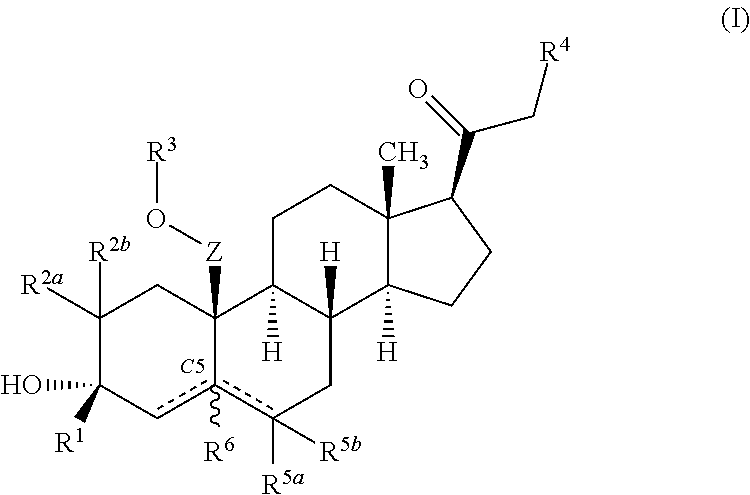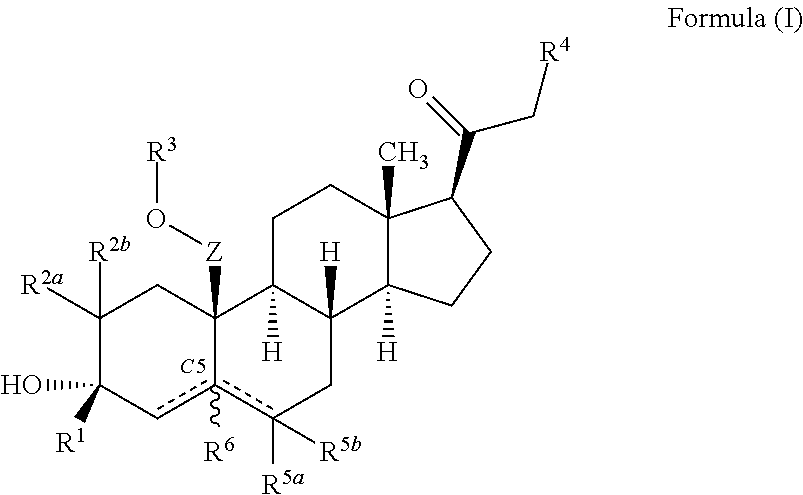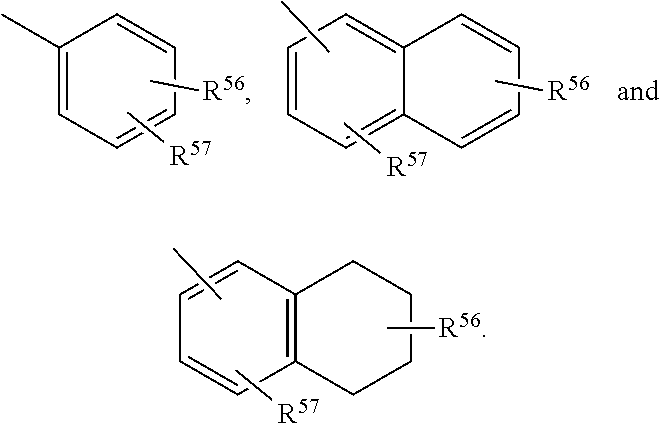Neuroactive steroids, compositions, and uses thereof
a technology of neuroactive steroids and compositions, applied in the field of neuroactive steroids, compositions, can solve the problems that progesterone is not consistently effective in the treatment of the aforementioned syndromes
- Summary
- Abstract
- Description
- Claims
- Application Information
AI Technical Summary
Benefits of technology
Problems solved by technology
Method used
Image
Examples
example 1
General Procedure A: Preparation of Compound 1
[0287]
[0288]Step 1. Preparation of compound A2. Finely-ground potassium hydroxide (28.0 g, 165 mmol) was added to a solution of commercially available 19-hydroxyandrost-4-ene-3,17-dione (A1, 50.0 g, 165 mmol) in anhydrous 1,2-dimethoxyethane (500 mL) at 0° C. under nitrogen, after which methyl sulfate (43.7 g, 208 mmol) was added portionwise. The mixture was slowly warmed to room temperature, stirring for a total of 18 h, at which point TLC analysis of the mixture (7:3 hexanes / ethyl acetate) indicated completion of the reaction. The mixture was diluted with water (500 mL) and extracted with ethyl acetate (3×200 mL). The combined organic extracts were washed with saturated aqueous sodium chloride solution (100 mL), dried with anhydrous sodium sulfate and filtered. The solvents were removed under reduced pressure and the residue was purified by column chromatography on silica gel, eluting with heptane / ethyl acetate (2:1), to provide A2 as ...
example 2
Preparation of Compound 2
[0297]
[0298]Step 1. Preparation of compound A11. Prepared according General Procedure A, Step 1 from 1 (10.0 g, 33 mmol) and ethyl sulfate (17.3 mL, 132 mmol), with purification by column chromatography on silica gel to provide compound A11 as a yellow oil (4.6 g, 42%).
[0299]Step 2. Preparation of compound A12. Prepared according General Procedure A, Step 2 from compound A11 (4.6 g, 14 mmol) to provide crude compound A12 as a yellow oil that was used in the next step without further purification.
[0300]Step 3. Preparation of compound A13. Prepared according General Procedure A, Step 3 from crude compound A12, with purification by column chromatography on silica gel to provide compound A13 as a yellow oil (1.5 g, 31%).
[0301]Step 4. Preparation of compound A14. Prepared according General Procedure A, Step 4 from compound A13 (1.7 g, 5.1 mmol) to provide crude compound A14 as a yellow oil that was used in the next step without further purification.
[0302]Step 5. ...
example 3
General Procedure C: Preparation of Compound 3
[0307]
[0308]Step 1. Preparation of compound B2. A mixture of commercially available 19-hydroxyandrost-4-ene-3,17-dione (A1, 13.6 g, 45 mmol) and palladium on carbon (3.2 g, 10 wt. %) in anhydrous tetrahydrofuran (150 mL) was shaken under an atmosphere of hydrogen (50 psi) at room temperature for 12 h, at which point TLC analysis of the mixture (2:1 hexanes / ethyl acetate) indicated completion of the reaction. The atmosphere was exchanged for nitrogen and the mixture was filtered through a pad of Celite under reduced pressure, washing the filter cake with ethanol. The filtrate solvents were removed under reduced pressure to provide B2 as a white solid that was used in the next step without further purification (13.0 g, 95%): LCMS m / z 305 [M+H]+.
[0309]Step 2. Preparation of compound B3. Pyridine hydrochloride (750 mg, 6.5 mmol) was added to a solution of crude compound B2 (15.0 g, 49 mmol) in ethylene glycol (65 mL) and anhydrous toluene (1...
PUM
 Login to View More
Login to View More Abstract
Description
Claims
Application Information
 Login to View More
Login to View More - R&D
- Intellectual Property
- Life Sciences
- Materials
- Tech Scout
- Unparalleled Data Quality
- Higher Quality Content
- 60% Fewer Hallucinations
Browse by: Latest US Patents, China's latest patents, Technical Efficacy Thesaurus, Application Domain, Technology Topic, Popular Technical Reports.
© 2025 PatSnap. All rights reserved.Legal|Privacy policy|Modern Slavery Act Transparency Statement|Sitemap|About US| Contact US: help@patsnap.com



